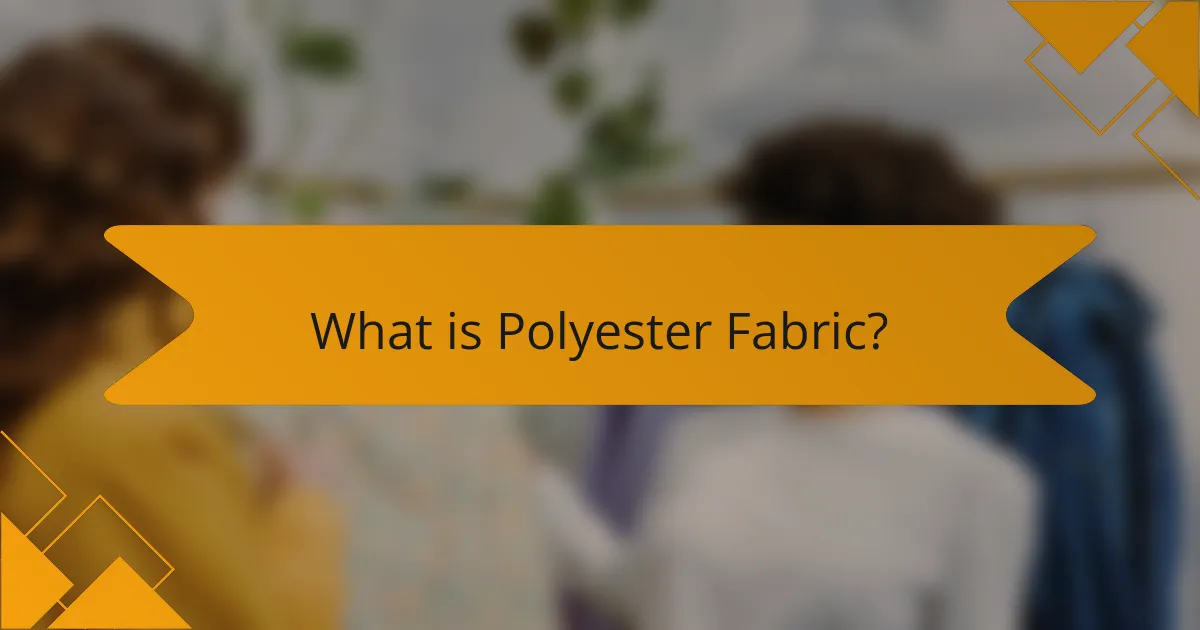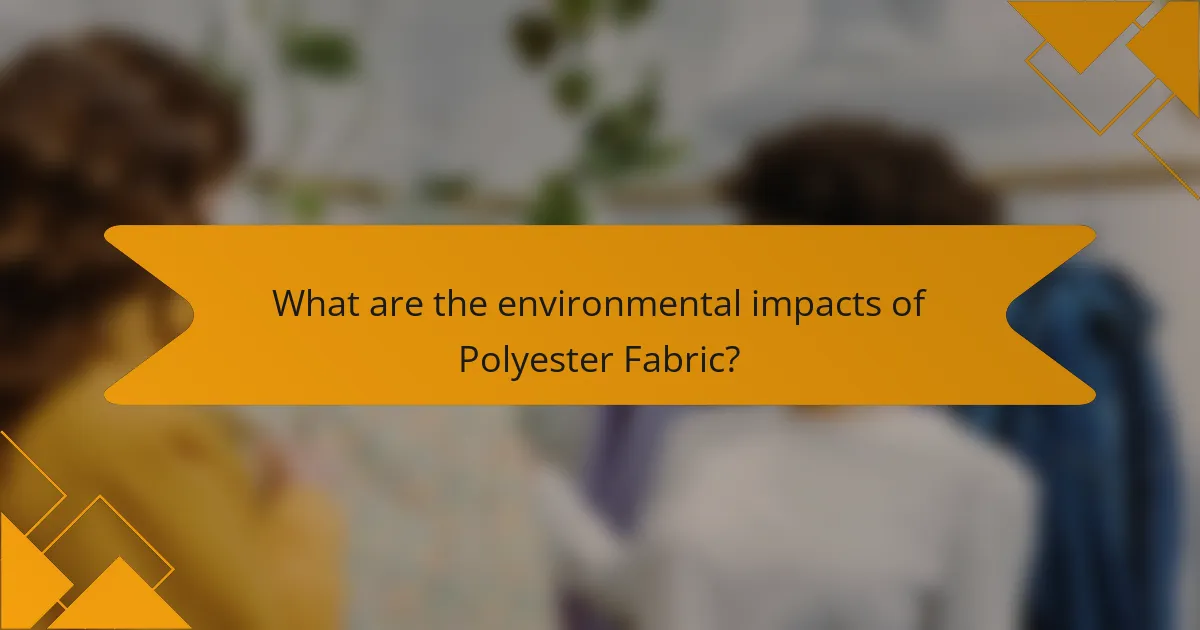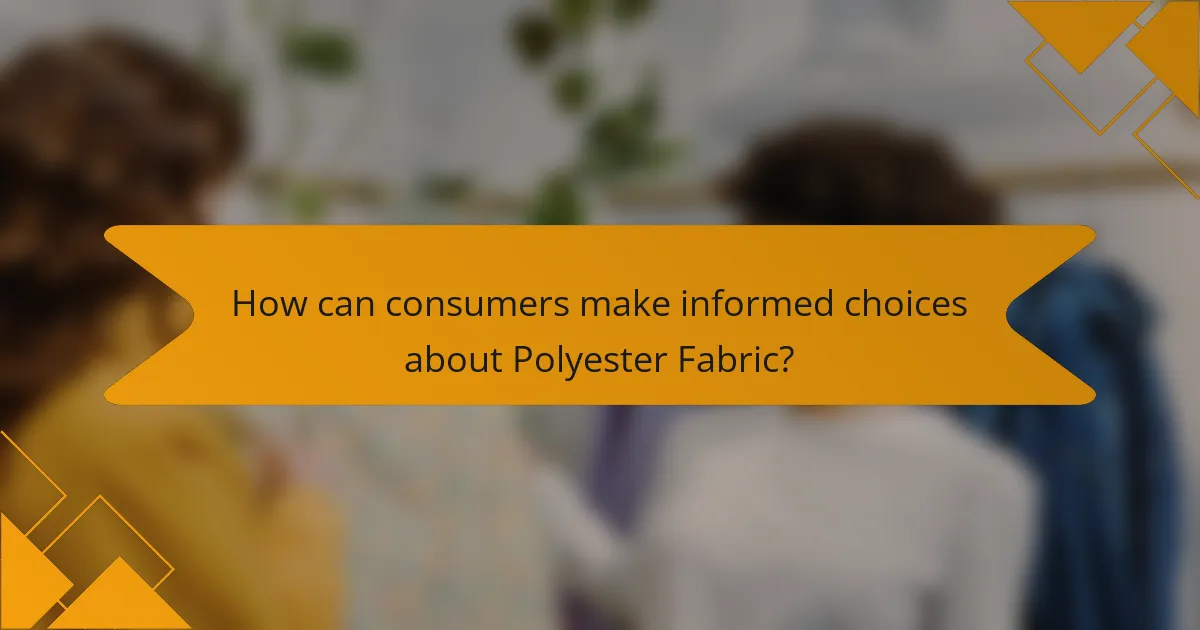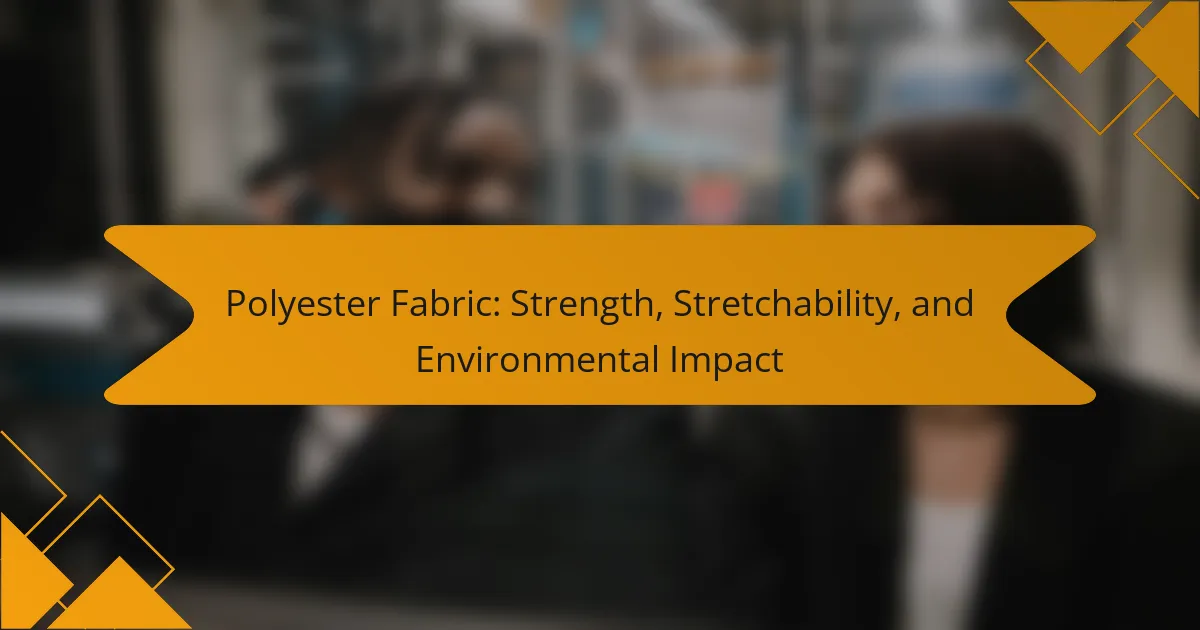Polyester fabric is a synthetic textile created from polyester fibers, recognized for its durability, resistance to wrinkles, and quick-drying properties. While commonly used in clothing and industrial applications, polyester’s production from petroleum-based products raises environmental concerns, including greenhouse gas emissions and non-biodegradability. The article discusses the fabric’s strengths, such as its wear resistance and versatility, alongside its environmental impact, including the contribution to microplastics in oceans. It also emphasizes the importance of consumer awareness regarding recycled polyester options and proper care to extend the lifespan of polyester products.

What is Polyester Fabric?
Polyester fabric is a synthetic textile made from polyester fibers. It is known for its durability and resistance to wrinkles and shrinking. Polyester is derived from petroleum-based products through a process called polymerization. This fabric is commonly used in clothing, upholstery, and various industrial applications. Its strength allows it to withstand wear and tear. Additionally, polyester fabric is often blended with other materials to enhance performance. The fabric dries quickly, making it suitable for activewear. Polyester is also resistant to mildew and abrasion, adding to its versatility.
How is Polyester Fabric produced?
Polyester fabric is produced through a chemical process involving polymerization. This process begins with the reaction of terephthalic acid and ethylene glycol, forming polyethylene terephthalate (PET). The resulting PET is then heated and extruded through spinnerets to create fibers. These fibers are cooled and solidified, forming long strands. Next, the strands are cut into staple fibers or left as continuous filaments. The fibers can then be spun into yarn and woven or knitted into fabric. This method allows for the creation of various polyester fabrics, known for their strength and durability.
What raw materials are used in the production of Polyester Fabric?
Polyester fabric is primarily produced from raw materials such as terephthalic acid and ethylene glycol. Terephthalic acid is derived from petroleum, while ethylene glycol is typically obtained from natural gas or crude oil. These materials undergo a polymerization process to form polyethylene terephthalate (PET), the key polymer used in polyester fabric. The production of PET involves a reaction between the two raw materials, resulting in a long-chain polymer. This polymer is then spun into fibers, which can be woven or knitted to create polyester fabric. The reliance on petroleum-based resources for these raw materials highlights the environmental concerns associated with polyester production.
What processes are involved in creating Polyester Fabric?
The processes involved in creating polyester fabric include polymerization, spinning, and weaving. Polymerization is the first step, where ethylene glycol and terephthalic acid undergo a chemical reaction to form polyethylene terephthalate (PET). This reaction typically occurs at high temperatures and pressures.
Next, the PET is melted and extruded through spinnerets to create long strands of fiber. This spinning process can be done using various methods, such as melt spinning or dry spinning. Once the fibers are formed, they are cooled and solidified.
After spinning, the polyester fibers are collected and can be further processed. These fibers are then woven or knitted into fabric. Weaving involves interlacing the fibers at right angles, while knitting creates loops of yarn.
Finally, the fabric may undergo finishing processes, such as dyeing and treating, to enhance its properties. Each of these steps is crucial in transforming raw materials into the final polyester fabric product.
What are the key characteristics of Polyester Fabric?
Polyester fabric is a synthetic textile known for its durability and versatility. It exhibits high strength, making it resistant to wear and tear. Polyester has excellent stretchability, allowing it to maintain its shape after washing. The fabric dries quickly due to its low moisture absorption. It is also resistant to shrinking and wrinkling, which enhances its ease of care. Polyester fabric can be easily dyed, providing vibrant colors and patterns. Additionally, it is often blended with other fibers to enhance performance. These characteristics make polyester a popular choice in various applications, including clothing and home textiles.
How does the strength of Polyester Fabric compare to other fabrics?
Polyester fabric is known for its high strength compared to many other fabrics. It has a tensile strength of approximately 4.5 to 6.5 grams per denier. This makes it stronger than cotton and wool, which typically have lower tensile strengths. Polyester also exhibits excellent resistance to stretching and shrinking. This durability allows polyester to maintain its shape and appearance over time. Additionally, polyester is resistant to mildew and abrasion, further enhancing its longevity. In contrast, fabrics like silk and rayon are more delicate and prone to damage. Overall, polyester fabric stands out for its strength and resilience in various applications.
What makes Polyester Fabric stretchable?
Polyester fabric is stretchable due to its elastic fibers. These fibers are made from a polymer called polyethylene terephthalate (PET). The molecular structure of PET allows for flexibility and resilience. This flexibility enables the fabric to return to its original shape after stretching. Additionally, the way polyester is woven can enhance its stretchability. Fabrics that incorporate spandex or elastane alongside polyester also provide increased stretch. The combination of these attributes makes polyester a popular choice in activewear and fitted clothing.
What are the common uses of Polyester Fabric?
Polyester fabric is commonly used in clothing, home textiles, and industrial applications. In clothing, it is favored for its durability and wrinkle resistance. Polyester blends are often used in sportswear due to their moisture-wicking properties. Home textiles such as curtains and upholstery often utilize polyester for its strength and ease of care. In industrial settings, polyester is used in manufacturing products like ropes and safety harnesses. The versatility of polyester fabric makes it suitable for a wide range of applications.
Which industries predominantly utilize Polyester Fabric?
The textile, fashion, and apparel industries predominantly utilize polyester fabric. Polyester is favored for its durability and resistance to wrinkles and shrinking. It is also widely used in the automotive industry for upholstery and interior fabrics. The home furnishings sector incorporates polyester in curtains, bedding, and upholstery. Additionally, the sportswear industry benefits from polyester’s moisture-wicking properties. The manufacturing of industrial textiles, such as conveyor belts and filters, also employs polyester. These industries leverage polyester for its versatility and performance characteristics.
How does Polyester Fabric perform in different applications?
Polyester fabric performs well in various applications due to its strength and durability. In apparel, it offers resistance to wrinkles, shrinking, and stretching. This makes it ideal for activewear and casual clothing. In home textiles, polyester is commonly used in upholstery and curtains for its easy maintenance and stain resistance. Additionally, polyester’s moisture-wicking properties enhance its performance in sportswear. In industrial applications, it is utilized for its high tensile strength and resistance to environmental factors. Studies show that polyester’s versatility makes it suitable for both functional and aesthetic purposes across multiple sectors.

What are the environmental impacts of Polyester Fabric?
Polyester fabric has significant environmental impacts. It is derived from petroleum, a non-renewable resource. The production process emits greenhouse gases, contributing to climate change. Polyester is not biodegradable, leading to long-lasting pollution in landfills. Microplastics from polyester can enter waterways, harming aquatic life. According to a study by the Ellen MacArthur Foundation, synthetic textiles contribute to 35% of microplastics in the oceans. Recycling polyester can reduce its environmental footprint but is not widely practiced. Overall, polyester’s lifecycle poses challenges for sustainability and environmental health.
How does the production of Polyester Fabric affect the environment?
The production of polyester fabric negatively affects the environment. It involves the use of petroleum-based resources, leading to fossil fuel depletion. The manufacturing process emits greenhouse gases, contributing to climate change. Additionally, the production generates significant water pollution from dyes and chemicals. Microplastics released during washing contaminate water bodies. According to the World Economic Forum, 35% of microplastics in oceans come from synthetic textiles like polyester. These environmental impacts highlight the need for sustainable alternatives in fabric production.
What are the carbon emissions associated with Polyester Fabric production?
The carbon emissions associated with polyester fabric production are significant. The production process emits approximately 3.5 kg of CO2 per kilogram of polyester. This is primarily due to the extraction and processing of petroleum, which is the raw material for polyester. Additionally, energy-intensive processes such as polymerization and spinning contribute to these emissions. A study by the Textile Exchange indicates that polyester production accounts for about 60% of the carbon footprint of the global textile industry. Therefore, the environmental impact of polyester fabric is substantial, highlighting the need for sustainable alternatives.
How does water usage in Polyester Fabric production compare to other fabrics?
Water usage in polyester fabric production is significantly lower compared to natural fabrics like cotton. Polyester production typically requires about 2,000 liters of water per ton of fabric. In contrast, cotton production can consume over 10,000 liters of water for the same amount of fabric. This stark difference is due to the agricultural needs of cotton, which necessitates extensive irrigation. Additionally, polyester is made from petroleum products, which do not require irrigation. Therefore, polyester fabric is more water-efficient in comparison to cotton and other natural fibers.
What are the sustainability challenges of Polyester Fabric?
Polyester fabric faces significant sustainability challenges. The production process requires large amounts of water and energy. Polyester is derived from petroleum, a non-renewable resource. This contributes to greenhouse gas emissions during its lifecycle. Additionally, polyester is not biodegradable. It can persist in the environment for hundreds of years. Microplastics released during washing contaminate waterways. These factors collectively hinder the sustainability of polyester fabric.
What are the issues related to microplastics from Polyester Fabric?
Microplastics from polyester fabric contribute to significant environmental issues. When washed, polyester garments release microfibers into water systems. These microfibers are too small to be filtered out by wastewater treatment plants. As a result, they enter oceans and rivers, affecting marine life. Research indicates that microplastics can be ingested by fish and other aquatic organisms. This ingestion can lead to harmful effects on their health and disrupt ecosystems. Furthermore, microplastics can accumulate in the food chain, potentially impacting human health. Studies show that microplastics have been found in seafood consumed by humans. This raises concerns about the long-term effects on human health and the environment.
How does recycling Polyester Fabric contribute to sustainability?
Recycling polyester fabric significantly contributes to sustainability by reducing waste and conserving resources. It minimizes the amount of polyester that ends up in landfills, where it can take hundreds of years to decompose. Recycling this fabric also lowers the demand for virgin polyester production. This process requires less energy and water compared to creating new polyester from petroleum. According to the Textile Recycling Association, recycling one ton of polyester can save up to 6,000 pounds of carbon dioxide emissions. Additionally, recycling reduces the extraction of fossil fuels, which are limited resources. Overall, recycling polyester fabric plays a crucial role in promoting a circular economy and reducing environmental impact.

How can consumers make informed choices about Polyester Fabric?
Consumers can make informed choices about polyester fabric by understanding its properties and environmental impact. Polyester is a synthetic fabric known for its durability and resistance to stretching and shrinking. It is also quick-drying and easy to care for. However, polyester production involves petrochemicals, contributing to environmental concerns.
To make informed choices, consumers should look for recycled polyester options. Recycled polyester reduces waste and energy consumption compared to virgin polyester. Additionally, checking for certifications like Global Recycled Standard can ensure sustainable sourcing.
Understanding the fabric’s care instructions is essential for longevity. Proper washing and drying methods can extend the life of polyester garments. Lastly, consumers should consider the end-of-life options for polyester, as it is not biodegradable.
By evaluating these factors, consumers can select polyester products that align with their values and needs.
What should consumers look for when purchasing Polyester Fabric?
Consumers should look for durability and strength when purchasing polyester fabric. Polyester is known for its resistance to wear and tear. It is also important to consider the fabric’s stretchability. High-quality polyester fabrics provide good elasticity and recovery. Additionally, consumers should check the fabric’s weight and thickness. Heavier polyester fabrics often offer better durability. The environmental impact of the fabric is also a key factor. Recycled polyester options can be more sustainable. Lastly, consumers should review the fabric’s care instructions. Easy maintenance can enhance the overall value of the purchase.
How can consumers identify high-quality Polyester Fabric?
Consumers can identify high-quality polyester fabric by examining its texture, durability, and appearance. High-quality polyester feels smooth and soft to the touch. It should not have a rough or scratchy texture. Additionally, the fabric should exhibit excellent resilience, meaning it retains its shape after stretching.
Consumers should also look for a vibrant color that does not fade easily. High-quality polyester resists wrinkling and shrinking, contributing to its longevity. The fabric should also be lightweight yet strong, indicating a good balance of strength and flexibility.
Furthermore, checking for a tight weave can indicate better quality. A tighter weave usually results in a more durable fabric. Lastly, reputable brands often provide certifications or labels that confirm the quality of their polyester fabric.
What certifications indicate sustainable Polyester Fabric?
Certifications that indicate sustainable polyester fabric include Global Recycled Standard (GRS) and Oeko-Tex Standard 100. GRS ensures that materials are recycled and produced in an environmentally friendly manner. Oeko-Tex Standard 100 certifies that textiles are free from harmful substances. Other certifications include the Recycled Claim Standard (RCS), which verifies the recycled content in products. These certifications help consumers identify environmentally responsible polyester fabrics.
What are some best practices for caring for Polyester Fabric?
To care for polyester fabric, wash it in cold water to prevent shrinkage and fading. Use a mild detergent to protect the fabric’s fibers. Avoid bleach, as it can damage polyester. Tumble dry on a low heat setting to maintain the fabric’s shape. Remove items promptly from the dryer to reduce wrinkles. Iron polyester on a low setting if necessary, using a pressing cloth to avoid direct heat. Store polyester items in a cool, dry place to prevent mildew and maintain quality. These practices help extend the life of polyester fabric and keep it looking its best.
How can proper care extend the life of Polyester Fabric products?
Proper care can significantly extend the life of polyester fabric products. Regular washing with mild detergents prevents fabric degradation. Avoiding high heat during drying helps maintain the material’s integrity. Storing polyester items in a cool, dry place prevents mold and mildew. Ironing at low temperatures protects the fabric from damage. These practices reduce wear and tear, keeping the fabric looking new longer. Studies show that proper maintenance can increase the lifespan of polyester by up to 50%.
What washing and drying methods are recommended for Polyester Fabric?
Washing polyester fabric is best done in cold or warm water. Use a gentle cycle to prevent damage. Avoid bleach as it can harm the fibers. For drying, tumble dry on a low heat setting. High heat can cause polyester to shrink or become misshapen. Air drying is also an option to maintain the fabric’s integrity. These methods help preserve the strength and stretchability of polyester.
Polyester fabric is a synthetic textile known for its strength, stretchability, and versatility across various applications, including clothing and industrial uses. The article explores the production processes, key characteristics, and common uses of polyester, highlighting its durability and resistance to wear. It also addresses the environmental impacts of polyester, including carbon emissions and microplastic pollution, while discussing the importance of recycling and sustainable practices. Additionally, consumers are guided on how to make informed choices when purchasing polyester fabric, including identifying high-quality options and best care practices.


